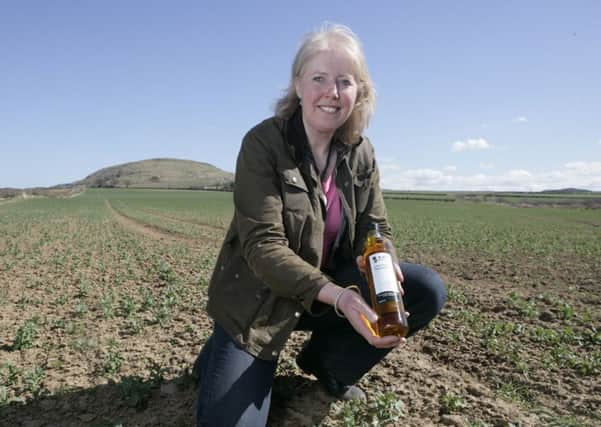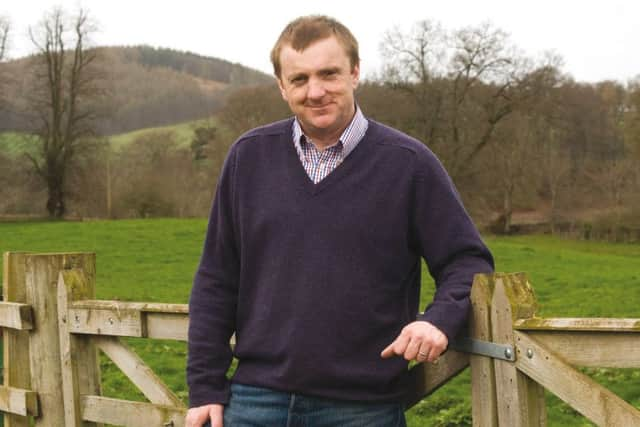Food & Drink Voices: how can we take advantage of £30bn opportunity?


Neil Forbes, chef proprietor, Cafe St Honoré, Edinburgh
As a busy city-centre restaurant, Cafe St Honoré relies heavily on trade from all sectors. Firstly I see the backbone of my business coming from a consistent local trade of folk on their way home who know they will be well looked after at the cafe.
Whisky will always be a strong market, at home and overseas, and the food sector is biting at the heels of these great brands.


Advertisement
Hide AdAdvertisement
Hide AdThe images we share with the world of clean waters, green fields and purple heather remains, but I feel a modern, new era is descending on Scotland, and it’s cool, it’s young, it’s upbeat. Think of the rise of street food, that’s about as far away from tartan-covered shortbread tins as you can imagine.
I am a huge believer in diversification and doing something new, something different. We have it all here in Scotland but I think we need to tap into our strengths a bit more, and encourage the next generation, and invest.
We really need this to be about allowing fewer multi-site hospitality brands to open, and offer support to independents.
My advice is:


– Intercept the produce before it leaves our communities.
– Pay a fair price for what you buy locally, and don’t try to compete with cheap, foreign food.
– Be part of your community. Grow veg, or empower yourself by volunteering. Don’t assume someone else will do it.
– Be proud of our heritage, food and culture, and inspire the next generation to take pride in traditional dishes like stovies, Scotch pies, bridies and Cullen skink.


– Sell to others at a high price, don’t undervalue what we have.
Rosemary Gallagher, head of communications, Scotch Whisky Association
Advertisement
Hide AdAdvertisement
Hide AdAcross the world, Scotland is recognised for its quality food and drink and Scotch Whisky, as the country’s biggest exporter in the sector, leads the way in this global recognition.
Each year around £4 billion of Scotch is sent to almost 200 markets, from large, mature markets such as the United States and France, to emerging markets in Asia and South America.


The current unprecedented level of investment in the industry, reflects the industry’s confidence that demand will grow.
And we want to help all Scottish food and drink sectors grow their exports.
That’s why we launched an Export Collaboration Charter in partnership with Scotland Food & Drink that sets out ten commitments to share best export practice, knowledge and networks.
By working together, Scotland’s larder will become even more attractive to overseas markets and we will all win from the £30 billion opportunity contained in the 2030 vision.
Prof Wayne Powell, principal and chief executive, Scotland’s Rural College
One opportunity is to connect primary production agriculture with health, nutrition and consumer preference with step changes in the health attributes of Scottish food and farming.


Advertisement
Hide AdAdvertisement
Hide AdThis will require a bigger role for social and behavioural sciences to integrate and connect science and technology “push”, such as digital technologies, with demand “pull” from consumers and citizens.
Inevitably, this will require greater collaboration and co-ordination across Scotland’s science landscape.
Also required will be a complete revitalisation of the sector’s skills base to nurture a future workforce with industry-shaped skills, capacity and entrepreneurial mindsets.
Scott Landsburgh, chief executive, Scottish Salmon Producers’ Organisation
The world is more connected, more populated and more prosperous than ever and Scotland must embrace the opportunities that brings.
Increasingly, consumers demand both high quality food and traceability from source to plate. In the salmon industry, we are fortunate to have held the French government’s prestigious Label Rouge quality standard for 25 years.
The French know their food and love the firm texture and superior taste of Scottish salmon and the complete traceability for each fish.
We have built upon this to enter other export markets like the United States and the Far East and they all want the same thing: quality and provenance.
Advertisement
Hide AdAdvertisement
Hide AdScottish salmon is now the UK’s leading food export, exporting to more than 60 countries.
Success has been no accident. Farmers are dedicated to delivering the freshest, tastiest, most nutritious salmon that money can buy.
If the whole Scottish food industry embraces this focus, the sky will be the limit.
Rachel Mirfattahi, food and drink sector engagement executive, Interface and Make Innovation Happen connector
The ambition to grow the food and drink industry to a turnover of £30 billion by 2030 is no doubt a challenge. However, with such a vibrant sector from farm, fishing and food & drink, innovation will play a key role as outlined in the food and drink strategy Ambition 2030.
Innovation underpins all areas of business from products, the processes used, the services provided and the staff you hire.
It’s about understanding your customer and how they operate in an evolving environment adapting to new technologies and changing consumer trends and lifestyles.
Businesses throughout the supply chain from farm to fork can be supported on their innovation journey through a new service called Make Innovation Happen.
Advertisement
Hide AdAdvertisement
Hide AdIt is a single gateway connecting food and drink businesses with innovation support delivered by the Scotland Food & Drink partnership.
The range of innovation support on offer includes tapping into universities and research institutes, world-renowned expertise and facilities through Interface.
Riddell Graham, director of partnerships, VisitScotland
Scotland’s reputation for quality and diverse food and drink has grown considerably in the past decade with visitor spend on food and drink reaching almost £1 billion during the Year of Food and Drink in 2015.
We continue to build on this success through VisitScotland’s Taste Our Best accreditation scheme by recognising the variety of Scotland’s food and drink that is available and promoted on menus across the country.
More than 1,000 food and drink businesses, like restaurants, B&Bs and hotels, to cafés and takeaways, promote the Taste Our Best badge as a sign that great quality Scottish food and drink is on the menu, prepared with care and delivered with passion.
Alan Laidlaw, chief executive, Royal Highland & Agricultural Society of Scotland
As the membership organisation that promotes the interest of farming, food and rural life, the Royal Highland & Agricultural Society of Scotland (RHASS) is firmly behind Ambition 2030.
Our relationship with 16,000 primary producers and processors around the country, who are members of RHASS, gives us direct access to the people who will make this vision a reality.
Advertisement
Hide AdAdvertisement
Hide AdBy promoting and supporting innovation as well as showcasing Scotland’s incredible food and drink to the world at the annual Royal Highland Show, RHASS is playing its part.
However, where we will see the greatest impact is through education: our work through the Royal Highland Education Trust (RHET) is delivering an informed next generation that is fully supportive of our farming and agri-food community.
Is this the best investment the industry can make to a sustainable future? Absolutely. It’s about creating solid foundations and attracting top talent that will deliver responsible growth.
Patrick Hughes, head, Seafood Scotland
Scotland’s food and drink sector can achieve the vision outlined in Ambition 2030 by cementing its place as a global leader in the production of premium food and drink brands.
Since 2007 and the inception of Scotland Food & Drink the industry has worked hard to implement a strong platform for success but now the hard work starts to build on this platform.
We have land and sea that are the envy of most countries and a skilled and passionate workforce, however we still have work to do in terms of innovation and collaboration.
With international buyers continually seeking one-stop shop options, future collaboration between food and drink businesses will significantly increase the value of the sector.
So from a seafood perspective, companies working together to provide a combined offering of salmon, white fish, shellfish and added-value options could see international trade move forward significantly.
Advertisement
Hide AdAdvertisement
Hide AdPaul Brown, leader food and drink sector group, Anderson Strathern
One of the key strengths of our Scottish food and drink is the quality and range of our produce.
This comes from our natural resources and the skill of those who harness them.
From the master blender to the Michelin starred chef, the skills required to enhance our natural larder and to make it stand out against global competition are key to our success.
Attracting people to the sector and providing training to develop the required skills is essential for the future of the industry.
While technological advancements will help, without trained people who know how to nurture the land and care for the seas, just when to pick that perfectly ripe strawberry or produce the finest steak, maintaining our unique selling point would be impossible.
Whether it is school leavers or older workers looking for a second career, encouraging and developing the required skills will be critical to the continued success of the sector and its impact on the Scottish economy.
Gordon Stark, chief operations officer, Murgitroyd
Building brands and expanding these on to the international stage will be key to future growth.
Advertisement
Hide AdAdvertisement
Hide AdIncreasing consumer awareness of the providence of the products which they buy and the story behind them has been embraced by many new companies entering the sector, who have successfully found new and innovative ways to engage consumers with their products and brands, whether that be through social media, crowdfunding or creating accessible and unique visitor experiences at factories, breweries and farms.
Building a strong brand identity within Scotland and then utilising international marketing hubs to align those products and brands with new international markets will be key to scalable and sustainable growth and will require many small scale artisan producers to embrace new and innovative ways to reach and supply global markets through creative collaborative supply chain solutions, such as export hubs.
Louise Elder, chair, East Lothian – Scotland’s Food & Drink County
When I first heard of the concept of a Business Improvement District for East Lothian’s food and drink sector, I felt that in a nutshell a BID formula suited the needs of our county’s producers to grow.
We are now innovative – the first food and drink BID in the world – and it can have sustainable impetus with a statutory levy and East Lothian Council support to bind us together.
We have a thriving food and drink industry in East Lothian and with many producers hard at the coalface of production – beer, flour, chocolate, meats, fish, spices, oil and honey to name a few – we needed help shouting about our successes to anyone outside East Lothian.
Working together is the way forward. We can share skill sets, collaborative sales and marketing, distribution, purchasing and warehousing and develop new products.
Marketing ourselves as Scotland’s Food & Drink County will grow our sales further afield. Collaboration is key to future success.
Eric Galbraith, lead partner food and drink group, Brodies
Advertisement
Hide AdAdvertisement
Hide AdScotland Food & Drink’s strategy lays down a challenge to every business in the sector to clarify its growth ambitions and establish how best it can use the “pillars of growth” – people and skills, supply chain and innovation – to achieve those objectives.
The real growth opportunity for the ambitious food or drink business is creating new markets in new territories, which has been a common denominator among our most successful clients in the sector.
They have found partners with both a strong position in their home market and a shared passion for the product.
The international reputation of Scottish produce now goes well beyond whisky and salmon. I was struck this summer to see locals at a French supermarket in the Languedoc buying Scottish cheddar for a family party, alongside brie.
We have come a long way and it’s now up to all of us to help build on that reputation and help the sector achieve its £30 billion target.
Jim McLaren, Perthshire beef cattle farmer and chairman, Quality Meat Scotland
As global demand for quality red meat continues to grow and consumers become more and more discerning, our industry’s iconic Scotch Beef PGI, Scotch Lamb PGI and Specially Selected Pork brands are well placed to grow.
We have an exceptional story to tell in terms of what lies behind the quality of our beef, lamb and pork.
Advertisement
Hide AdAdvertisement
Hide AdIt is under pinned by world-leading quality assurance schemes which make animal welfare a priority.
It is produced in a sustainable manner using the best of traditional techniques along with the latest innovation. We have a great sustainability message in terms of the contribution of livestock farming to the environment and to maintaining Scotland’s enviable landscape.
But, most important of all, we have beef, lamb and pork producers who are 100 per cent committed to doing the best job they can and producing a product which not only tastes great, also has the integrity and provenance demanded by the consumer.